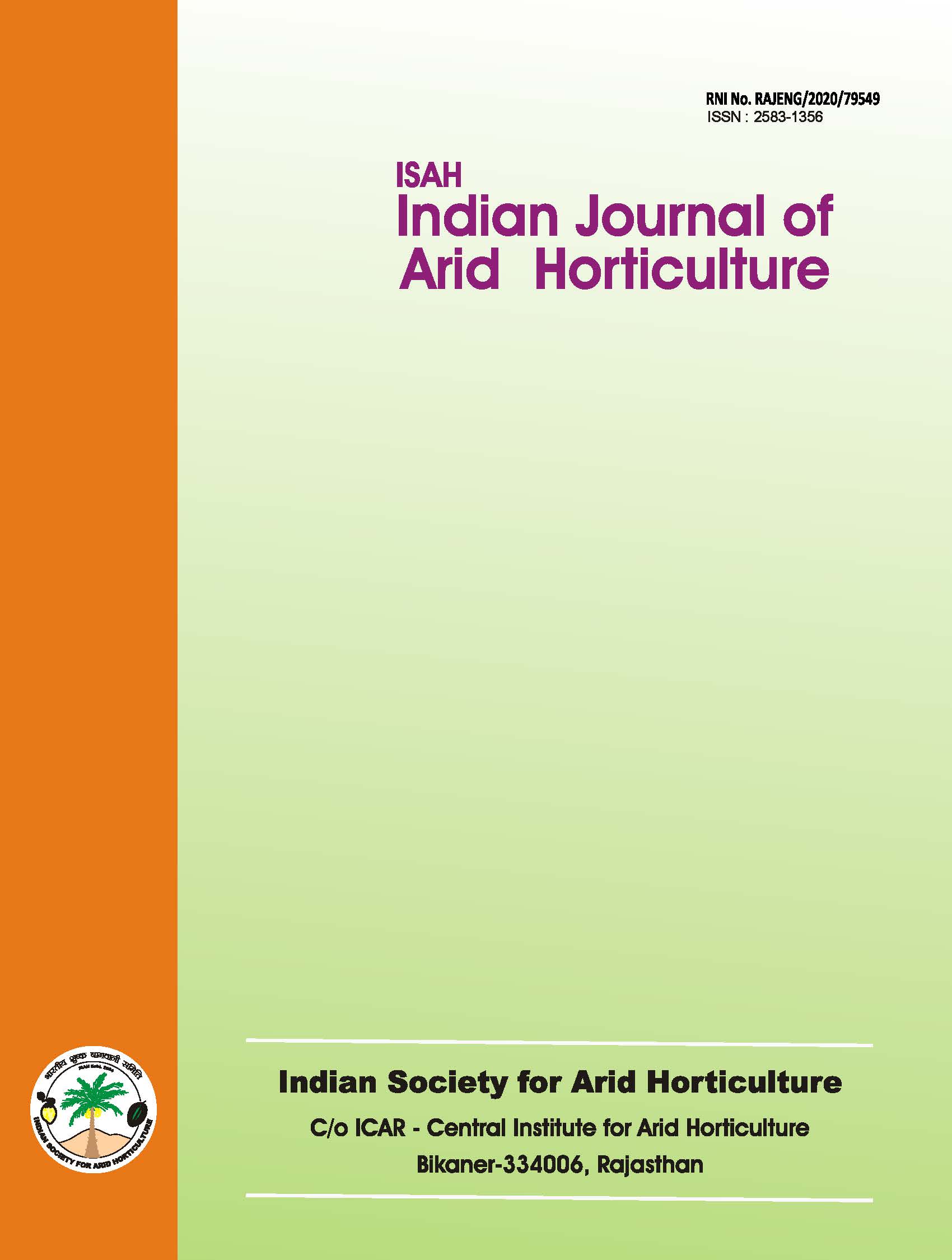Evaluation of Morinda tomentosa accession under zero irrigation conditions of semi-arid ecosystem
Keywords:
morphological, illustrated, pineappleAbstract
Morinda sp. belongs to family Rubiaceae and the about particular genotype was selected. A total of sixteen plant is believed to have originated in India and South East fruits were randomly collected from all the direction of each Asia and to be precise in Andaman and Nicobar Islands genotype to record the qualitative and quantitative (Singh, 2009). It is also known by different vernacular morphological characters. The extent of variation in names in different parts of world like nuna, ach, Indian physico-chemical traits of fruits from different location was mulberry, awl, great Morinda, cheese fruit, mouse's recorded. Atotal of 20 genotypes were collected which had pineapple, jumbie breadfruit, hog apple, pain killer, fairly wide spectrum of variability with respect to growth, mengkudu, aledi and bilimbi. It is grown wildly in many flowering, fruiting behaviour and quality attributes. The places throughout India viz. Madhya Pradesh, Gujarat, samples of leaf, bud, flower and fruit were brought to the Rajasthan, Andhra Pradesh etc. It is hardy green small tree laboratory for morphological study and fruit quality bearing flowers and fruits throughout the year under attributes. The observations on qualitative characteristics different agro-climatic conditions, but more prominently like tree habit, and leaf morphology were recorded visually. during rainy season (April to August). Plants of different Observation on the leaf morphology was in terms of leaf species of Morinda spp. are found to be growing in fragile shape, leaf apex, leaf margin and leaf colour was taken as edephoclimatic conditions and adapted to acidic, alkaline illustrated by Wilde et al., 1972 and Simpson, 2006.
Downloads
References
A. O. A. C. 1990. Official Methods of Analysis, 15th edn. Association of Official Analytical Chemists, Washington D.C., U.S.A.
Cambie, R. C. and Ash, J. 1994. Fijian Medicinal Plants. CSIRO, Australia.
Cooke, T. H. 1908. The Flora of Presidency of Bombay. Vol II, Calcutta, pp. 43.
Gomez, K.A. & Gomez, A.A. 1984. Statistical Procedure for Agricultural Research (2nd Edn.), John Wiley and Sons Inc., New York.
Gupta, V., Singh, A. K., Pandey, C. D., Kak, A., Arya, L., and Ramya, K. N. 2011. Morphological diversity in Noni (Morinda citrifolia L.) from Kerala. National Symposium on Noni: A Panacea of Wellness, 1-2 October, Chennai, pp. 142-150.
Simpson, M.G. 2006. Plant Systematics. Netherlands: Elsevier Academic Press.
Singh, A. K., Singh, S., Joshi, H. K., Bagle, B. G., More, T. A., and Sisodia, P. S. 2008. Survey, identification, collection, and evaluation of Morinda spp. under semi-arid ecosystem. Proceedings Published in the National Seminar on Status and Future Strategies of Horticultural Development in A&N Islands, 23rd to 25th Jan., 2009 at CARI, Port Blair.
Singh, A. K., Singh, Sanjay, and Joshi, H. K., Bagle, B. G., More, T. A., and Sisodia, P. S. 2010. Genetic variability of Morinda spp. for morphological features of Western India. First World Noni Congress, Noni for Global Wellness, 1st-3rd October, 2010 at Chennai, pp. 72-80.
Singh, A. K., Singh, Sanjay, and Joshi, H. K., and Sisodia, P. S. 2011. Evaluation of Morinda tomentosa Heyne ex Roth genotypes under semi-arid ecosystem of Gujarat. National Symposium on Noni: A Panacea of Wellness, 1-2 October, Chennai, pp. 111-120.
Singh, D. R., Srivastava, A. K., Srivastava, A., and Srivastava, R. C. 2009. Ethno Medicinal Plants of Andaman and Nicobar Islands: Current Status and Future. Proceedings of the National Symposium on Noni for Nutrition and Health, New Delhi, 18th and 19th October, pp. 133-39.
Wilde, S. A., Voigt, G.K., and Iyer, J. G. 1972. Soil and Plant Analysis for Tree Culture. New Delhi, Bombay & Calcutta: Oxford & IBH Pub. Co.
A. K. Singh, S. Singh, H. K. Joshi, and Purnima Makwana. 2013. Indian Journal of Arid Horticulture, 8(1-2): 71-75.

